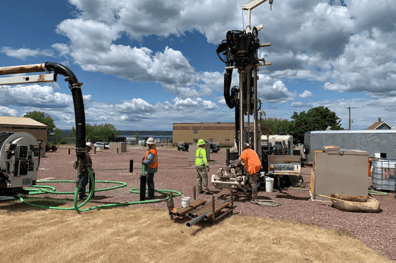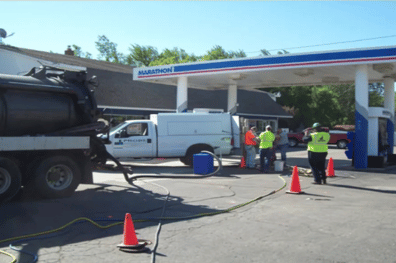Corrosion of an oil water separator at an operating locomotive service building resulted in the release of LNAPL into the subsurface. ORIN successfully treated soil and groundwater utilizing a combination of in-situ chemical oxidation and vacuum extraction. Nine injection points were advanced to an injection interval of 15 to 10 ft bgs using Geoprobe direct push technology with each point receiving an average of 50 gallons of treatment chemistry. Four points received an additional 25 gallons each for a total of 550 gallons.
Three nearby wells were used as extraction wells to allow for hydraulic control of groundwater to assist with the distribution of the remedial chemistry and to remove free product and highly contaminated groundwater. A VAC truck was present to vacuum extract from the extraction wells during all injection activities. Approximately 1,300 gallons was extracted during the pilot test.
The Challenge
The site presented unique operational challenges:
- Active railroad facility
- Oil-water separator corrosion
- LNAPL contamination
- Need for rapid response
- Operational continuity requirement
- 2.13 feet of free product thickness
The Solution: Dual Treatment Approach
The team implemented an integrated strategy:
- Chemical Treatment:
- Nine strategic injection points
- 15-10 ft below ground surface
- 50 gallons per point standard treatment
- Additional 25 gallons at four points
- Total injection: 550 gallons
- Calcium peroxide and catalyzed sodium persulfate
- Extraction System:
- Three extraction wells
- VAC truck deployment
- 1,300 gallons extracted
- Hydraulic control maintenance
- Continuous monitoring
Rapid Results
The treatment achieved exceptional speed:
- 72-Hour Results:
- Initial thickness: 2.13 feet
- Final thickness: 0 feet
- Complete elimination of free product
- Verified through well monitoring
Long-Term Benefits
The treatment provided ongoing advantages:
- Residual calcium peroxide continued oxygen release
- Enhanced natural bioremediation
- Sustained treatment effectiveness
- Minimal operational disruption
Key Success Factors
Several elements contributed to rapid success:
- Strategic injection point placement
- Integrated extraction system
- Hydraulic control maintenance
- Optimal chemistry selection
- Continuous monitoring
Innovation Highlights
The project demonstrated several advantages:
- Rapid contamination elimination
- Minimal facility disruption
- Sustained treatment effects
- Effective hydraulic control
- Compatible with active operations
Practical Applications
This approach provides solutions for:
- Active facility remediation
- Emergency response situations
- LNAPL contamination
- Industrial site treatment
- Time-critical projects
This case study demonstrates how strategic planning and innovative technology can achieve rapid contamination elimination while maintaining critical facility operations.



